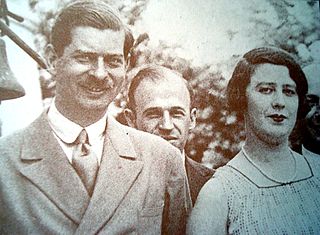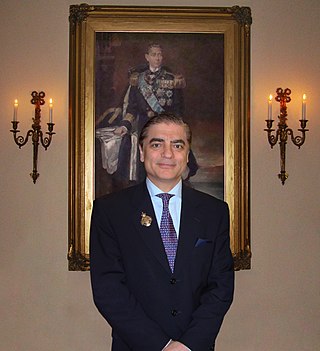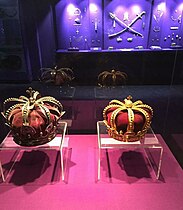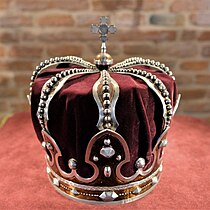
Michael I was the last king of Romania, reigning from 20 July 1927 to 8 June 1930 and again from 6 September 1940 until his forced abdication on 30 December 1947.

Ferdinand, nicknamed Întregitorul, was King of Romania from 1914 until his death in 1927. Ferdinand was the second son of Leopold, Prince of Hohenzollern, and Infanta Antónia of Portugal, daughter of Ferdinand II of Portugal and Maria II of Portugal. His family was part of the Catholic branch of the Prussian royal family Hohenzollern.

The King of Romania or King of the Romanians, was the title of the monarch of the Kingdom of Romania from 1881 until 1947, when the Romanian Workers' Party proclaimed the Romanian People's Republic following Michael I's forced abdication.

Carol I or Charles I of Romania, born Prince Karl of Hohenzollern-Sigmaringen, was the monarch of Romania from 1866 to his death in 1914, ruling as Prince (Domnitor) from 1866 to 1881, and as King from 1881 to 1914. He was elected Prince of the Romanian United Principalities on 20 April 1866 after the overthrow of Alexandru Ioan Cuza by a palace coup d'état. In May 1877, Romania was proclaimed an independent and sovereign nation. The defeat of the Ottoman Empire (1878) in the Russo-Turkish War secured Romanian independence, and he was proclaimed King on 26 March [O.S. 14 March] 1881. He was the first ruler of the Hohenzollern-Sigmaringen dynasty, which ruled the country until the proclamation of a socialist republic in 1947.

Peleș Castle is a Neo-Renaissance castle in the Carpathian Mountains, near Sinaia, in Prahova County, Romania, on an existing medieval route linking Transylvania and Wallachia, built between 1873 and 1914. Its inauguration was held in 1883. It was constructed for King Carol I.

Marie was the last Queen of Romania as the wife of King Ferdinand I.

The coat of arms of Romania was adopted in the Romanian Parliament on 10 September 1992 as a representative coat of arms for Romania. The current coat of arms is based on the lesser coat of arms of interwar Kingdom of Romania, which was designed in 1921 by the Transylvanian Hungarian heraldist József Sebestyén from Cluj, at the request of King Ferdinand I of Romania, it was redesigned by Victor Dima. As a central element, it shows a golden aquila holding a cross in its beak, and a mace and a sword in its claws. It also consists of the three colors which represent the colors of the national flag. The coat of arms was augmented on 11 July 2016 to add a representation of the Steel Crown of Romania.

Magda Lupescu, later officially known as Princess Elena of Romania, was the mistress and later wife of King Carol II of Romania.

The Cathedral of Curtea de Argeș is a Romanian Orthodox cathedral in Curtea de Argeș, Romania. It is located on the grounds of the Curtea de Argeș Monastery, and is dedicated to Dormition of the Mother of God. The building is the seat of the Archdiocese of Argeș and Muscel.

Anne was the wife of King Michael I of Romania. She married Michael in 1948, the year after he had abdicated the throne. Nonetheless, she was known after the marriage as Queen Anne.

Margareta, Custodian of the Crown of Romania is the eldest daughter of King Michael I and Queen Anne of Romania. She assumed her father's duties in March 2016, upon his retirement, and has claimed the headship of the House of Romania since his death on 5 December 2017. She also heads the Margareta of Romania Royal Foundation.

Princess Elena of Romania is the second eldest daughter of King Michael I and Queen Anne of Romania.

Paul-Philippe al României, also known as Prince Paul of Romania, Paul-Philippe Hohenzollern and Paul Lambrino, is the son of Carol Lambrino and Hélène Henriette Nagavitzine. His father was the elder son of King Carol II of Romania and Zizi Lambrino. Paul-Philippe claims that he, and not Margareta of Romania, is the rightful head of the royal house of Romania.

Helen of Greece and Denmark was the queen mother of Romania during the reign of her son King Michael I (1940–1947). She was noted for her humanitarian efforts to save Romanian Jews during World War II, which led to her being awarded by the State of Israel with the honorific of Righteous Among the Nations in 1993.

Prince Radu of Romania is the husband of Margareta of Romania, head of the House of Romania and a disputed pretender to the former Romanian throne. On 1 January 1999, he was given the name, not title, of "Prince of Hohenzollern-Veringen" by Friedrich Wilhelm, Prince of Hohenzollern, the Head of the Sigmaringen branch of the Hohenzollern family. He has also called himself "Radu Hohenzollern-Veringen-Duda". Since 2007, when he had his legal name changed from "Radu Duda" to "Radu al României Duda", Radu no longer uses the name of Hohenzollern. The Fundamental Rules of the Romanian Royal Family, proclaimed by former King Michael I on 30 December 2007, gave Radu the title of "Prince of Romania", with the style of "Royal Highness", which King Michael had given him earlier on 5 January 2005.

The Royal Palace of Bucharest, known as Palace of the Republic between 1948 and 1990, is a monumental building situated in the capital of Romania, on Calea Victoriei. The palace in its various incarnations served as official residence for the kings of Romania until 1947, when the communist regime was installed after Michael I of Romania's forced abdication. Since 1950, the palace hosts the National Museum of Art of Romania. The Romanian royal family currently uses Elisabeta Palace as its official residence in Bucharest. In addition, the Romanian government allows the royal family to use the Royal Palace different occasions.
The Regalia of Romania are a set of items which were used for the coronation of the kings and queens of Romania. They are currently housed in the National Museum of Romanian History in Bucharest. The regalia consist of the Royal Crown, the Crown of Queen Elizabeth, the Crown of Queen Maria, orbs, the Scepter of King Ferdinand I the Scepter of King Carol II, the Sword of King Carol I and the Royal Mantle.
The Decorations of the Romanian Royal House are a reward for conspicuous and special merits of the recipients for the Romanian state and the Romanian Royal House.

Săvârșin Castle is a large Country house situated in Săvârșin Park, a 6.5-hectare (16-acre) private estate that was owned by King Michael I of the Romanians (1921–2017) in Săvârșin, Arad County, Romania.

On 5 December 2017, Michael I of Romania, former head of the House of Romania and former King of Romania from 1927 to 1930 and 1940 to 1947, died at his private residence in Switzerland at the age of 96, in the presence of his youngest daughter Princess Maria.




























